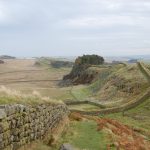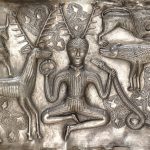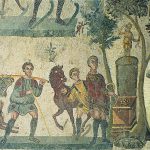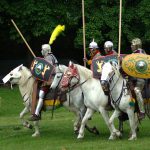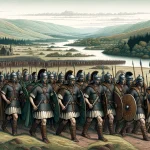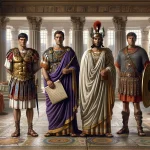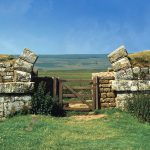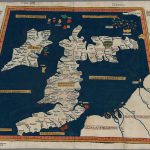Netherby (Castra Exploratorum) Roman Fort
Flavian Auxiliary Fort (AD 69–96) and Vicus
The site of the Netherby Roman fort is now completely obliterated by the monumental living-quarters and landscaped gardens of Netherby Hall, a 15th century Tower House which is thought to have been built directly upon the site of the fort’s principal buildings, re-using a large quantity of Roman construction material within the fabric of its own seven-feet-thick stone walls. Over the years, extensions to the original mansion house and additional outbuildings such as the coach-house, stables, ice-house, coop-house and outlying gardens and orchards, have gradually removed all trace of Roman occupation.
Despite the lack of physical evidence concerning the dimensions and alignment of the fort’s defenses, we may make deductions based on the type of garrison units it is known to have housed; it would appear from recovered inscriptions that the site must have seen at least two military encampments and we may postulate at least two others. The first recorded garrison was Cohors I Nervanorum, a five-hundred strong regiment of foot-soldiers which was probably stationed here c.125AD and would have required a fort of about 3 to 4 acres (c. 1.2 – 1.6 ha); the later resident unit, Cohors I Hispanorum, comprised a nominal one-thousand men and about three-hundred horses, which would require an occupation area of anything between 6 to 9 acres (c. 2.4 – 3.6 ha), depending on the frugality or generosity of the living-quarters within its defenses.
It is generally assumed that the known Hadrianic occupation of the site was probably preceded by an earlier establishment during the Agricolan Campaigns c.80AD, but the strength and composition of the garrison at this time remains unknown and, indeed, unproven. The location of the associated settlement, in the area to the north-west of the fort, implies that the original camp probably faced in this direction, across the Esk into Dumfries & Galloway. It should also be noted that the Roman name for the site, ‘The Fort of the Scouts’, itself implies a very small mounted garrison unit during the late-Roman period, perhaps numerus or a cuneus, which again points to another, much smaller fort or fortlet on the site.
Classical References for Castra Exploratorum
Mentioned only in the Antonine Itinerary, the identification of Netherby with the Castra Exploratorum of Iter II is nontheless fairly certain. This station occurs near the start of the second itinerary, where it is recorded between Blatobulgium (Birrens, Dumfries & Galloway) the northern terminus of Iter II and Luguvalium (Carlisle, Cumbria). The recorded distance from Netherby to both of these posting-stations is the same, namely twenty-two Roman miles, however, this does not fit the actual measured distances very well at all, though it is feasible that at the time the Antonine Itinerary was produced, the Roman road between Netherby and Carlisle took a dog-leg east along the Stanegate to Old Church, in order perhaps to avoid the marshes of the Solway Estuary.
The name Castra Exploratorum is easily translated as the Fort or Camp of the Exploratores. These were part-mounted auxiliary units recruited from among tribes noted for their tracking and hunting skills, and used primarily to reconnoitre enemy territory, akin to the Scouting service of colonial America.
The Builders of the Netherby Forts
RIB 974 - Dedication to Hadrian by Second Legion Augusta
For the Emperor Caesar Trajan Hadrian Augustus the Second Legion Augusta built (this).
HADRIANO
AVG
LEG II AVG FEC
Pennant (Scotland 1772 ii (1776) 409 no. 10) records, with expansions here excluded, a text reading Imp CaesARI (presumably for IMP CAES) TRAIAN HADRIAN LEG II AVG, which Wilson, Prehist. Ann. (1851) 396 ‘possibly’, Huebner CIL vii 961, and Macdonald, PSAS 30 (1896-6) 149 equate with CIL vii 961. Birley, Cumb. Westm. AAST 2nd Ser. 53 (1953) 21 considers this to be a separate stone. But Pennant’s texts are often faulty and at least two stones from elsewhere (RIB 1747, 2288) are cited as being ‘preserved … in the same place’, i.e. Hoddom Castle, although no other record associates them with that place R.P.W.Bainbrigg had a copy of it at Appleby, and this was lost before Hayton’s time (1722). Morton (between 1738 and 1768) records it apparently as being in a house of the Grahams ‘in Eskdale’, i.e. Netherby, but he is probably only reproducing Camden.
RIB 981 - Building inscription of the Sixth Legion
A detachment of the Sixth Legion Victrix Pia Fidelis (built this): of the Sixth Legion Pia Fidelis.
Probably derived from Netherby fort. Birley considers that it may have come from Hadrian’s Wall.
There was perhaps a further bout of construction during the reign of Commodus, as building work within the fort was dedicated to him (vide RIB 975 infra), perhaps by contingents of Legio Sextae Victrix whose work is also recorded (vide RIB 981 supra).
RIB 975 - Inscription
In the consulship of the Emperor Commodus.
Birley, loc. cit., explains that this presumably came from the end or one side of an altar, to date its dedication in A.D. 177; cf. RIB 2026 Stanwix, of A.D. 167.
RIB 980 - Dedication to an unknown emperor by the Twentieth Legion and the First Aelian Cohort of Spaniards
For the Emperor … detachments of the Second Legion Augusta and the Twentieth Legion Valeria Victrix, also the First Aelian Cohort of Spaniards one thousand strong, part-mounted, (set this up) under the charge of Modius Iulius imperial propraetorian legate, under the direction of Aelius …
The whole of the text as recorded is recut, and appears thus in the earliest record, made by Hutchinson. The original text as now visible, either between the recut letters or on the portion where no recutting has taken place, is too faint to be recovered. The first line, however, contains evident traces of an ancient erasure. If this is an imperial title, as is most likely, its position does not suit the recut text and suggests that, when the recutting was done, the original text was already so obliterated as to preclude any faithful reproduction in the recutting. It is thus impossible either to restore the original text or to accept the recut version with any confidence R.P.W. Addenda from RIB+add. (1995): This named an emperor whose memory was expunged, judging by the ancient erasure in 1. Birley Fasti, 187, takes the recut text to be a transcript of what was read at the time, which is a reasonable idea, though antoiii in 1 is against it, since an original antonino would have been erased. Birley’s unparalleled b[i]s cos in 2 is also difficult to take. But otherwise his restored text is preferable to R.P.W.’s counsel of despair. This text, slightly adapted, with unresolved text in left in capitals, appears above. For Modius Iulius cf. RIB 1914.
Further work was perhaps undertaken by Cohors I Hispanorum who left four datable inscriptions ranging from 213 to 222ADAD. A further inscription dated to c.215-20AD records the work of this auxiliary unit along with vexillations from Legio II Augusta and Legio XX Valeria Victrix, but the stone has been recut and the reading is unreliable (Vide supra).
The Garrison Units
RIB 966 - Altar dedicated to Cocidius
To the holy god Cocidius, Paternius Maternus, tribune of the First Cohort Nervana, promoted from evocatus Palatinus, willingly and deservedly fulfilled his vow.
SANCTO
COCIDIO
PATERNIVS
MATERNVS
TRIBVNVS COH
I NERVANE
EX EVOCATO
PALATINO
V S L M
Mommsen (EE v p. 150) considered Palatinus to mean special palace duties. Birley (to R.P.W., 9 Dec. 1958) explains the adjective as the choice of an ex-guardsman advertising his former rank. Whether he had first occupied another post as an evocatus is not clear.As Birley states (Cumb. Westm. AAST 2nd Ser. liii (1953) 27) ‘there is no record of the discovery of this altar’. He considers that ‘there are grounds for suspecting that it really comes from Bewcastle’, because a transference is proved for 1765 (PSAN 2nd Ser. ii (1885) 144, note on LS 785), because the stone is ‘quite unlike the red sandstone usually employed for Netherby inscriptions’, and because Cocidius was officially worshipped at Bewcastle. He dates the stone to the second half of the third century (Cumb. Westm. AAST 2nd Ser. xxxix (1939) 219), revising his previous fourth-century date (Cumb. Westm. AAST 2nd Ser. xxxi (1931) 139) based on the title ex evocato Palatino, and considers it to be an official dedication by the prefect on behalf of coh. I Nervana, which he now suggests was at Bewcastle in the third century (Cumb. Westm. AAST 2nd Ser. liii (1953) 27) as against his former tentative location at Burgh-by-Sands (Cumb. Westm. AAST 2nd Ser. xxxix (1939) 219). But whitish sandstone was used for some indubitable Netherby inscriptions (e.g. RIB 978, 979, 980); Cocidius was widely worshipped in North Cumberland; and the inscription need not be an official dedication, as Birley himself has observed (Cumb. Westm. AAST 2nd Ser. xxxix (1939) 219). The whole matter remains so open to opinion that pending further evidence the stone is left at Netherby in accordance with Birley’s suggestion of 1939 (loc. cit.), though the third-century garrison was coh. I Ael. Hispanorum. Addenda from RIB+add. (1995): 8. For evocatus see Birley, ZPE 43 (1981), 25-29 = Mavors iv, 326-30, and Glossary.
RIB 976 - Dedication to Caracalla and Julia Domna
… for Julia Augusta, mother of our Emperor Marcus Aurelius Antoninus and of the Army and Senate and country, out of their common duty and devotion to his Divinity, under the charge of Gaius Julius Marcus, emperor’s propraetorian legate, the First Aelian Cohort of Spaniards, one thousand strong, part-mounted, set this up.
M MATRI AV[...]
[... ...]
ELII ANTON[...]
ET CASTR [...]
SENATVS ET
PATRIAE PRO
[... ...]
DEVOTIONE
[...]
NVM EIVS
[... ...]
MARC[...] L[...]
PR PR COH [...] AEL
[...]
POSVIT
See RIB 1235 for another text citing Julia Domna, and RIB 1202 with note for similar dedications of A.D. 213.The stone is described by Camden as an altar (ara). This is most unlikely in view of the nature of the inscription. It was probably the jamb of a doorway, perhaps the sacellum of the Headquarters Building, which would have a base and capital not unlike an altar (cf. RIB 1593, Housesteads, and RIB 327, Caerleon). A corresponding jamb may be expected to have carried the first half of the text recording Caracalla and his full style R.P.W. Addenda from RIB+add. (1995): Discussed by Daniels, Arch. Ael. 5th ser., viii (1980), 71, in the light of a new text from Newcastle (Brit. xi (1980), 405 No. 6).
This part-mounted unit is named on several stone inscriptions including five dated to the first quarter of the third century. It would seem that the regiment occupied the Netherby fort during the campaigns of Severus and Caracalla into Scotland between 208AD and 212, and were perhaps stationed there more or less permanently afterwards.
RIB 977 - Building dedication by the First Aelian Cohort of Spaniards
… the First Aelian Cohort of Spaniards, one thousand strong, part-mounted, styled Antoniniana, built this from its foundations under the charge of Gaius Julius Marcus, emperor’s propraetorian legate, under the direction of … Maximus, tribune.
[... ...] ANTO
[...]Ạ EX SOLO
[...] SVB CVR G IVL
[...]G AVG PR PR INSTANTE
[...]Ṛ MAXIMO TRIB
Haverfield at first (Cat. (1899) no. 79) assigned this text to the early third century. Later, on adopting the view of Bruce that the lettering fitted the period of Antoninus Pius or Marcus Aurelius, he dated it to this latter period, noting (in EE ix p. 610) that G. Iul[… could not be Julius Verus, as his praenomen was Cn(aeus).McCaul, quoted by Bruce LS, suggested that the governor might be G. Julius Marcus. Birley, loc. cit., noting the complicated ligatures and restoring ll. 1, 2 as Anto|[niniana] assigns it to G. Julius Marcus (A.D. 214-16). For dedications of A.D. 213 citing G. Julius Marcus see RIB 1202.
RIB 979 - Building dedication by the First Aelian Cohort of Spaniards
… the First Aelian Cohort of Spaniards, one thousand strong, part-mounted, Severiana Alexandriana, restored this temple, lately fallen in through excessive age, and completed it according to its previous pattern when the Emperors our Lords … (were consuls).
⟦[...]VERIANA [...]⟧
TEMPLVM NV[...]
TATE CONLABSV[ ...]
AD PRISTINAM [...]
MAVIT IMP D [ ...]
[...]
From l. 2 Severiana and the pair of emperors in l. 6 the date lies within 13 Mar.-31 Dec. 222.
The Axelodunum entry in the Notitia Dignitatum
There is apparently some confusion in the Notitia Dignitatum concerning the Wall fort at Stanwix (Uxelodunum) which is listed in the N.D. under the name Petrianis, after the garrison unit the Ala Gallorum Petrianum, even though its official name was Uxelodunum. But, … there is another entry in the N.D. for a fort named Axelodunum, obviously, meaning the Stanwix fort, but listing the garrison unit as Cohors I Hispanorum, which is the attested garrison of the Netherby fort. In light of this, it seems likely that the N.D. entry for Castra Exploratorum was mistakenly named Axelodunum.
RIB 978 - Building dedication to the Emperor Severus Alexander by First Aelian Cohort of Spaniards
For the Emperor Caesar Marcus Aurelius Severus Alexander Pius Felix Augustus, pontifex maximus, with tribunician power, consul, father of his country, the First Aelian Cohort of Spaniards, one thousand strong, part-mounted, devoted to his Divinity and majesty, built a cavalry drill-hall, long since begun from the ground, and completed it, under the charge of Marius Valerianus, emperor’s propraetorian legate, under the direction of Marcus Aurelius Salvius, tribune of this cohort in the consulship of our Lo
SEVERO ALEXANDRO PIO [...]EL AVG
PONT MAXIMO TRIB POT COS P P COH I AEL
HISPANORVM ↀ EQ DEVOTA NVMINI
MAIESTATIQVE EIVS BASELICAM
EQVESTREM EXERCITATORIAM
IAM PRIDEM A SOLO COEPTAM
AEDIFICAVIT CONSVMMAVITQVE
SVB CVRA MARI VALERIANI LEG
AVG PR PR INSTANTE M AVRELIO
SALVIO TRIB COH IMP D N
SEVERO ALEXANDRO PIO FEL
AVG COS
For Marius Valerianus see RIB 1060 (South Shields), 1465 (Chesters).For M. Aurelius Salvius see RIB 968 (Netherby).
When the above inscription was first discovered archaeologists and historians greeted it with great enthusiasm as it gave the actual name the Romans employed for the large riding-hall attached to the front of the principia in many auxiliary cavalry forts (see note #2, above).
The Gods of Castra Exploratorum
Over the years a number of stone altars have been unearthed at Netherby, some of which were dedicated to the familiar gods of classical Roman mythology although almost half offer thanks to gods of Germanic origin. The classical deities are; Apollo the sun-god and patron of music, the goddess Fortune (vide supra), Silvanus the god of the forest, Mars the war god and Jupiter the leader of the Roman pantheon. The Germanic gods represented are Cocidius (vide RIB 966 supra), Huetirus, Moguntus and Belatucader. There is also one altarstone to an unknown deity (RIB 967; not shown), which has been considerably damaged.
RIB 971 - Altar dedicated to Mogons Vitiris
To the holy god Mogons Vitiris, Aelius Secundus willingly and deservedly fulfilled his vow.
MOGONT
VITIRE SAN
AEL [...]
V S L M
No commentary.
RIB 969 - Altar dedicated to Jupiter Optimus Maximus
No commentary.
RIB 973 - Altar dedicated to Hueter
To the god Hveter.
HVE
TIRI
See Birley for a discussion of the sides, and the connexion with Hercules. Addenda from RIB+add. (1995): ‘This is the most exquisitely carved altar in Roman Britain and its quality is far superior to that of other altars to the Veteres, although its size is similar’: Coulston and Phillips, CSIR i, 6. 189.
RIB 968 - Altar dedicated to Fortuna Conservatrix
To the holy goddess Fortuna Conservatrix Marcus Aurelius Salvius, tribune of the First Aelian Cohort of Spaniards, one thousand strong, part-mounted, willingly and deservedly fulfilled his vow.
AE FORTVNAE
CONSERVATRICI
MARCVS AVREL
SALVIVS TRIBVN
VS COH I AEL HI
SPANORVM
ↀ EQ
V S L M
For M. Aurelius Salvius see RIB 978 (A.D. 222) Netherby.
RIB 965 - Altar dedicated to Apollo
To the god Apollo … Aurelius Maternus for the welfare of himself and of … willingly and deservedly fulfilled his vow.
[.] AVRELIVS M[...]
TE[...]NVS PRO
S[...]LV[...]E [...]VA ET MI [.] IIANAISA
MA [.] V S L M
No commentary.
RIB 970 - Altar dedicated to Mars Belatucadrus
To Mars Belatucadrus Aurelius Nicanor gladly, willingly, and deservedly fulfilled his vow.
BELATVCADRO
RO [...]VR [...]CA[...]
OR V S [ ] M
No commentary.
RIB 972 - Altar dedicated to Silvanus
To the god Silvanus.
SILV
No commentary.
It has been mooted that the Brocara entry in the The Ravenna Cosmography (RC#156), which appears between the entries for Fanocodi (Bewcastle, Cumbria) and the unknown station Croucingo, may refer to the civilian settlement outside the ‘Camp of the Scouts’; there is no corroborative evidence to support this. The Brocara entry in the RC is now thought to apply to the fort at Brougham (Cumbria), which was named Brocavum.
Even though nothing remains of either the fort or its associated civil settlement, we are lucky in that the site has been visited over the years by several antiquarians, historians and amateur archaeologists who recorded a number of Roman features in the area. Stukeley reported that the mansion house was surrounded by the buildings of a Roman fort; Stukeley, Gale and Goodman reported that a Roman vicus settlement lay outside the north-west defences of the fort extending down towards the River Esk, where Leland observed moumental buildings and evidence of a river port, now silted-up. Stukeley also saw a Roman cemetery outside the fort, although he does not state on which side, but this probably lay to the south-east, farthest away from the settlement site.
A Roman bath-house lying on one of the side-streets in the vicus was discovered and investigated by antiquarians in 1732 but the exact location was not recorded. It may be postulated, however, that the bath-house was supplied with fresh water via the stream issuing from Friar’s Bush and if this was the case, the baths building probably lay in the north-eastern part of the settlement just to the north of the fort, thereby to avoid having to convey the fresh water needed by such an establishment over the line of the road leading north-westwards into Scotland.
RIB 984 - Funerary inscription for Titullinia Pussitta
To the spirits of the departed Titullinia Pussitta, a Raetian, lived 35 years, 8 months, 15 days ..
TITVLLINIA
PVSSITTA
CIS RAETA
VIXSIT
ANNOS XXXV
MENSES VIII
DIES XV
TV
No commentary. Addenda from RIB+add. (1995): 9. The letters tu appear to be a later, possibly modern, addition: CSIR i, 6. 235.
The RIB records a single tombstone from Netherby which is, oddly enough, that of a woman, named Titullinia Pussitta (vide infra). It is possible that she was the wife of one of the unit commanders stationed at the fort, who would be the only woman (apart from domestic slaves in her household) you would normally expect to find in a military camp. The inscription however, does not name the bereaved husband let alone his rank, which would be expected if she was the wife of a senior officer.
- The Roman province of Raetia lay mostly in south-east Gemany, extending into eastern Austria and the south-western part of the Czech Republic.
The absence of the husbands name and titles from her memorial indicates that Titullinia was more likely the wife of an ordinary soldier or perhaps even a native merchant, and as such would not be entitled to live inside the fort, but in a street-settlement or vicus positioned outside the defences of the camp. These small villages were normally located along each side of the road issuing from the main gate of a Roman fort, and the vicus at Netherby has been identified to the north-west, between Castra Exploratorum and the River Esk, where there was probably some sort of crossing in Roman times. The site of the 19th century steel suspension bridge, built solely for the benefit of the folk at Netherby Hall in order to attend the Church at Kirkandrews on the opposite side of the river, is no indication of the site of the postulated Roman crossing, which probably lay a little further upstream.
Map References for Castra Exploratorvm
References for Castra Exploratorvm
- Chronicle of the Roman Emperors by Chris Scarre (Thames & Hudson, London, 1995);
- Chronology of the Ancient World by E.J. Bickerman (Thames & Hudson, London, 1980);
- The Roman Inscriptions of Britain – Vol.1 – Inscriptions on Stone by R.G. Collingwood & R.P. Wright (Oxford 1965);
Roman Roads near Castra Exploratorvm
Iter II: WSW (15) to Blatobvlgivm (Dumfries & Galloway) Possible Road: N (7.5) to Broomholm (Dumfries & Galloway) S (8) to Uxelodvnvm (Stanwix, Cumbria) possible early road: SE (10) to Old Chvrch (Cumbria)
Sites near Netherby (Castra Exploratorum) Roman Fort
- Gilnockie Temporary Camp (8 km)
Marching or Temporary Camp - Broomholm Roman Fort (10 km)
Flavian Auxiliary Fort (AD 69–96) - Hadrian's Wall - Milecastle 62 - Walby East (12 km)
Hadrian's Wall Milecastle - Hadrian's Wall - Milecastle 61 - Wallhead (12 km)
Hadrian's Wall Milecastle - Hadrian's Wall - Milecastle 63 - Walby West (13 km)
Hadrian's Wall Milecastle - Hadrian's Wall - Milecastle 60 - High Strand (13 km)
Hadrian's Wall Milecastle - Moss Side Camps (13 km)
Marching or Temporary Camp - Hadrian's Wall - Milecastle 64 - Drawdykes (13 km)
Hadrian's Wall Milecastle - Hadrian's Wall - Milecastle 59 - Old Wall (13 km)
Hadrian's Wall Milecastle - Hadrian's Wall - Milecastle 70 - Braelees (14 km)
Hadrian's Wall Milecastle
